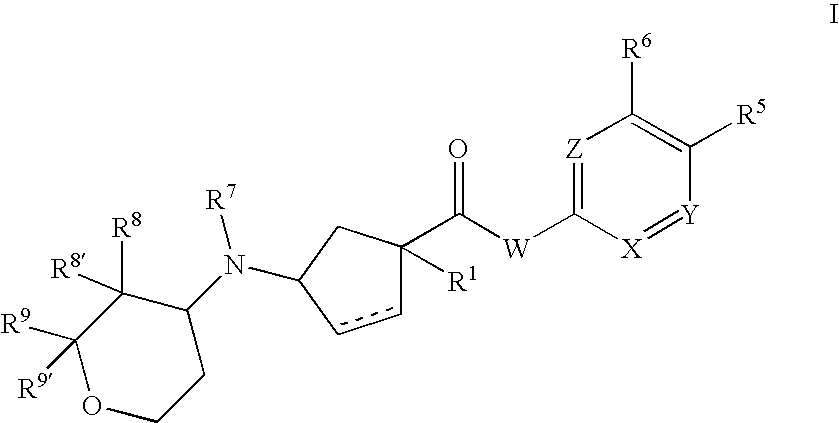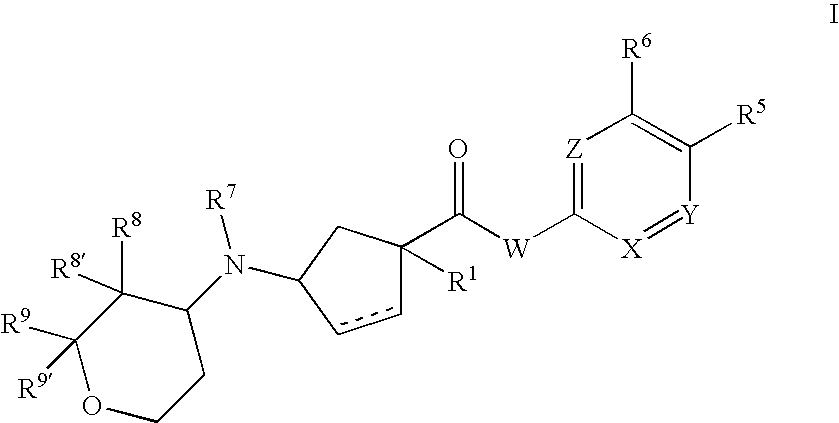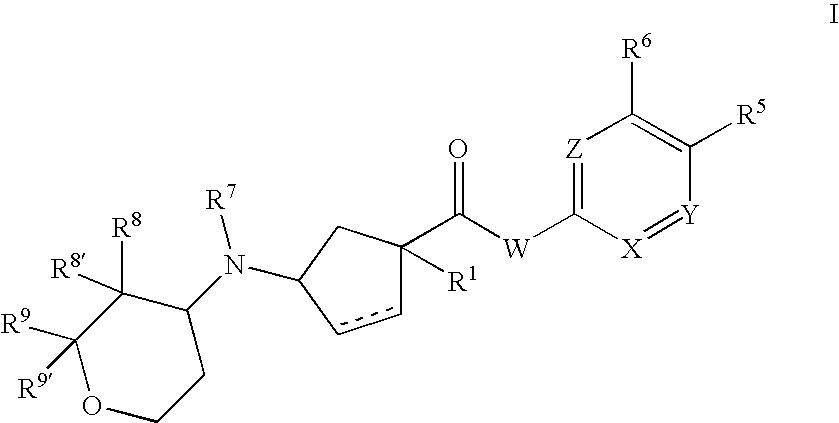3-aminocyclopentanecarboxamides as modulators of chemokine receptors
- Summary
- Abstract
- Description
- Claims
- Application Information
AI Technical Summary
Benefits of technology
Problems solved by technology
Method used
Image
Examples
example 1
Preparation of N-[(1R,3S)-3-isopropyl-3-({4-[3-(trifluoromethyl)phenyl]piperazin-1-yl}carbonyl)cyclopentyl]-3-methoxytetrahydro-2H-pyran-4-amine
[0209]
4,4-Dimethoxytetrahydro-2H-pyran-3-ol
[0210] To a solution of 4-methoxy-3,6-dihydro-2H-pyran (5.00 g, 43.8 mmol) in methanol (100 mL) at 0° C. was dropwise added a solution of m-chloroperbenzoic acid (15.1 g, 87.6 mmol) in methanol (15 mL). After being stirred for 5 h, methanol was removed in vacuo and the white residue was dissolved in methylene chloride (300 mL). To the solution was added K2CO3. The resulting solution was stirred for 1 h and filtered through celite. The filtrate was evaporated in vacuo to provide the desired product which was used directly for the next reaction without purification.
Step A-2
[0211] 3,4,4-Trimethoxytetrahydro-2H-pyran
[0212] To a solution of 4,4-dimethoxytetrahydro-2H-pyran-3-ol (6.00 g, 37.0 mmol) in THF (100 mL) at 0° C. was added sodium hydride (1.48 g, 37.0 mmol). After being stirred at 0° C. ...
example 4
[0232] Preparation of N-[(1R,3S)-3-isopropyl-3-({4-[5-(trifluoromethyl)pyridin-3-yl]piperazin-1-yl}carbonyl)cyclopentyl]-3-methoxytetrahydro-2H-pyran-4-amine
Step A-1
3-Bromo-5-iodopyridine
[0233] To a solution of 3,5-dibromopyridine (48 g, 200 mmol) in THF (200 mL) was added a 2 M solution of isopropylmagnesium chloride in THF (80 mL). After being stirred at room temperature for 2 h, the solution was cooled to −78° C. To it was added a precooled solution of iodine (51 g, 200 mmol) in THF (100 mL). The mixture was diluted with ether and washed with a saturated solution of ammonium chloride, a 2 M solution of sodium thiosulfate, and brine. The resulting organic layer was dried over MgSO4, filtered and concentrated. Crystalization from ethanol gave 33.5 g (58%) of desired product. 1H NMR (CDCl3) δ 8.75 (1H, s), 8.60 (1H, s), 8.20 (1H, s).
Step A-2
tert-Butyl 4-(5-bromopyridin-3-yl)piperazine-1-carboxylate
[0234] A solution of 3-bromo-5-iodopyridine (13.0 g, 45.8 mmol) , tert-bu...
example 5
[0241] Preparation of N-{(1R,3S)-3-isopropyl-3-[(4-phenyl-3,6-dihydropyridin-1(2H)-yl) carbonyllcyclopentyl}-3-methoxytetrahydro-2H-pyran-4-amine
Step A
tert-Butyl {(1R,3S)-3-isopropyl-3-[(4-phenyl-3,6-dihydropyridin-] (2H)-yl) carbonylycyclopentylycarbamate
[0242] In a dried flask, (1 S,3R)-3-[(tert-butoxycarbonyl)amino]-1-isopropyl-cyclopentanecarboxylic acid (200 mg, 0.7 mmol) and 4-phenyl-1,2,3,6-tetrahydropyridine (160 mg, 0.81 mmol) were suspended in methylene chloride (4 mL) under N2. Triethylamine (0.22 g, 2.2 mmol) was added followed by benzotriazol- 1-yloxytris (dimethylamino)phosphonium hexafluorophosphate (0.36 g, 0.81 mmol). The reaction was stirred overnight at room temperature and quenched by addition of saturated NaHCO3 solution. The resulting solution was extracted with methylene chloride three times. The combined extracts were dried (MgSO4), filtered and concentrated. Purification by flash chromatography on silica gel (gradient: 0-45% B over 15 min. Bottle A=he...
PUM
| Property | Measurement | Unit |
|---|---|---|
| Pharmaceutically acceptable | aaaaa | aaaaa |
Abstract
Description
Claims
Application Information
 Login to View More
Login to View More - R&D
- Intellectual Property
- Life Sciences
- Materials
- Tech Scout
- Unparalleled Data Quality
- Higher Quality Content
- 60% Fewer Hallucinations
Browse by: Latest US Patents, China's latest patents, Technical Efficacy Thesaurus, Application Domain, Technology Topic, Popular Technical Reports.
© 2025 PatSnap. All rights reserved.Legal|Privacy policy|Modern Slavery Act Transparency Statement|Sitemap|About US| Contact US: help@patsnap.com



